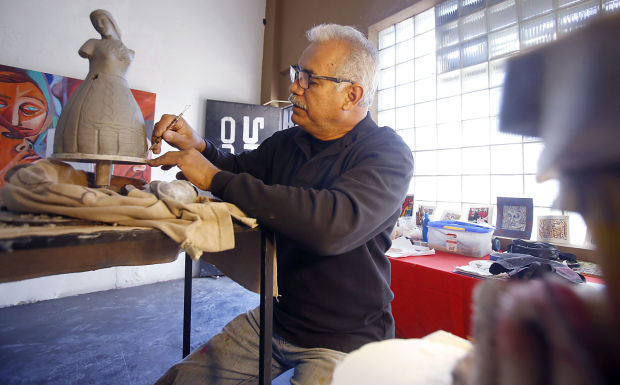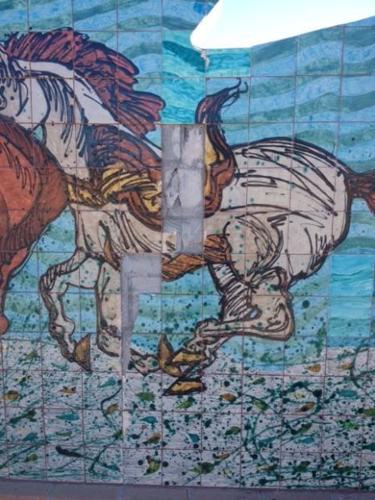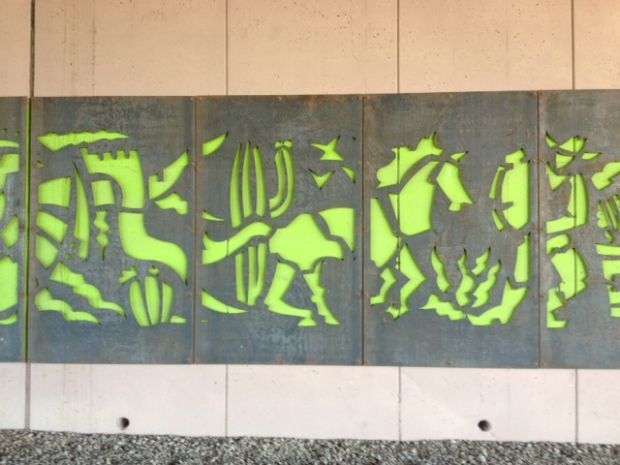Etching the fine lines on a small clay figure, a prototype for an olive-oil containter, in an East Toole Avenue studio, Tucson artist Gonzalo Espinosa may let his mind wander to a larger project he is contemplating.
Can’t blame him if he does. The larger project is occupying much of his time. It will be one of Espinosa’s proudest achievements, among a long list of artistic accomplishments for the Mexican-born muralist.
The project is made up of three large murals — one in terra cotta, the other a painting and the third mosaic tile — for a public housing/community center/commercial complex in Seattle. Espinosa and longtime Tucson collaborator Alex Garza are working on a public arts project for a 112-unit mixed-use development in that city’s Centro de la Raza.
Espinosa and Garza were tapped for the project because of their incorporation of “Latino culture and history through significant and culturally relevant artworks of substantive quality and beauty,” said the project’s organizers.
The Tucson artists will design and create art for exteriors and interiors of the buildings and Casto Solano, a Basque sculptor in Spain, will create a memorial to honor Roberto Maestas, the founder of Seattle’s El Centro de la Raza. The art project is expected to cost about $400,000, Espinosa said.
“It’s important because of its size,” said Espinosa, who is known in the Tucson area, from South Tucson to Oro Valley, for his many public art muralsy.
One mural will measure 27 feet high by 10 feet wide and will be terra cotta relief. Another mural with the painted image of la Virgen de Guadalupe will be 18 feet tall and 14 feet wide. The third will be a 15-foot by 10-foot mosaic image of José Martí, the 19th-century Cuban revolutionary leader, an important figure in Latin American literature and the namesake of the Centro’s child development center.
Espinosa expects the project to be completed in 18 months. He and Garza will face a number of challenges: the rain and cold in Seattle being at the top of the list, and coordinating the artwork with the construction of the buildings.
But Espinosa is up to the challenges.
“It’s natural for us,” he said.
Maybe it’s the law of public-works artists who have to conform to the various elements and factors that play into their work. Working with terra cotta, for example, in the dry heat of Southern Arizona is one thing. Working in sunless Seattle is another. The artists will create their works in Tucson and transport them to Seattle.
Long-term projects are not unusual for Espinosa, 60, who has been working as an artist for 40 years after studying in Guadalajara, Mexico.
In South Tucson, Espinosa created nine mosaic tile murals that line a one-mile section of South 10th Avenue. That project, more than 10 years ago, took him two years to complete.
Another project, of a different kind, occupied Espinosa for many years. In the early 1990s, Espinosa and Garza were artistic directors for Las Artes Youth Arts and Learning Center in South Tucson. Through the arts, youths were schooled and given better options in their lives.
Through Las Artes, the more than 20 murals in South Tucson were created. The murals on winding South Fourth Avenue, a mecca of Sonoran cuisine, are projects of Las Artes.
Espinosa returns to those works in South Tucson on the weekends. He revisits his works out of necessity. Some are in need of retouching. Some tiles have fallen off. A few others are tagged with graffiti. Espinosa, on his own time and own dime, is repairing and repainting the murals.
It’s personal. The murals are his works, his artistic and public legacy.
His wish is to have the South Tucson murals restored, inventoried and catalogued, and have them marketed as a destination point. If people can make a pilgrimage to eat at South Tucson’s popular restaurants, he asks, why not to see the many public works of arts?
“We need to preserve these,” he said.






